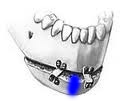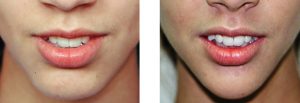Changes in the chin are traditionally perceived as the need for a horizontal increase or improved anterior projection. While many chin deficient patients need horizontal augmentation, there are other dimensions in which the chin may need to be changed. Vertical lengthening or shortening is the other most recognized alteration that can be done to the chin.
The least recognized and often overlooked chin change is in its width or transverse dimension. Increasing the width of the chin is done in male chin augmentation, usually using an implant to get a more square or wider masculine appearance. Narrowing the chin, however, can obviously not be done with an implant. Like vertical chin shortening, only a chin osteotomy can reliably make that change.
Burring of the sides of the chin from an intraoral approach can make for a more narrow or pointed chin but it has limits as to what can be achieved. This is best thought of some mild chin contouring. There is also the issue of extensive soft tissue release with a burring technique and there is no guarantee of good soft tissue readaptation afterwards. This is why a chin osteotomy may be preferred when a significant narrowing effect is aesthetically desired.


While a chin osteotomy is needed when a significant narrowing effect is needed, there are other considerations for its use as well. Certain chin shapes when advanced by osteotomy may be still too wide in the frontal view. This can be seen with certain women’s chins. Changing the chin to one with less width can be aesthetically advantageous as it comes forward, resulting in more of a u-shape and creating the perception of some flare to the jaw angles as well.
Dr. Barry Eppley
Indianapolis, Indiana


